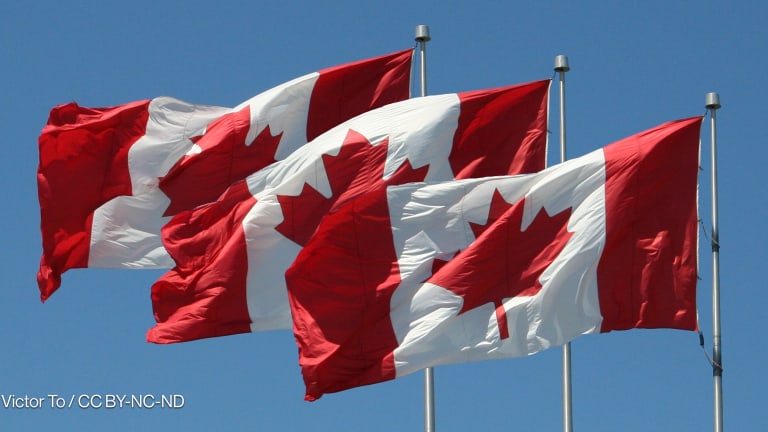
Advocates had high hopes for Canada’s aid 2017 budget. As United Nations agencies and international NGOs brace for promised cuts from the United States, some saw Canada as a candidate to fill gaps in aid funding.
Prime Minister Justin Trudeau’s doggedly optimistic statements and open stance toward refugees bolstered the hopes. After Canada’s lead role in hosting the latest Global Fund replenishment conference in Montreal last fall, and as the resettlement program of Syrian refugees reached the 40,000 mark, local civil society organizations expected new financial commitments to the aid program.
Instead, the budget, released on March 22, does not foresee increases for the next five years. It does not to disclose details on the International Assistance Envelope, making it difficult to assess how and when the funding will be spent.
More details will likely follow the release of Canada’s International Assistance Review, a major consultation to redefining the country’s international development policy and funding frameworks. In the meantime, here are five key takeaways from what we know about the 2017 budget so far.
1. No clear path to reach 0.7 percent target for aid.
During three months of consultations for the upcoming review, civil society organizations lobbied the Canadian government to increase official development assistance up to 0.7 percent of Canadian GNI. Organizations told Devex they were disappointed that the 2017 budget includes no scheduled increase in international assistance for five years from 2016-17 levels, approximately 5.7 billion Canadian dollars ($4.28 billion).
With constant spending, the aid budget will continue to decrease from its current 0.26 percent of Canada’s GNI, and could fall below its lowest rate since 1965 by 2022. “The lack of new resources for international development at this juncture in history is embarrassing,” said Julia Sánchez, president and CEO of the Canadian Council for International Co-Operation, when reached by Devex. “Canada is letting Canadians and the world down.”
2. Don’t expect Canada to fix global funding shortfalls.
Canada’s recent pledge at the She Decides conference in Brussels earlier this year was seen as a sign that Trudeau’s government was willing to help mitigate U.S. cuts to sexual and reproductive health. But the CA$20 million ($14.9 million) donation was also a reallocation of unspent money from the 2016-2017 international assistance envelope, and may remain exceptional.
A stagnant ODA budget will make it difficult for Canada to foot its own development expenses, let alone fill in international gaps left by other donors’ retreats. Amanda Sussman, head of policy at Plan International Canada, told Devex that other Plan International offices had been hoping for additional funding from Canada, after encouraging statements from Justin Trudeau and International Development Minister Marie-Claude Bibeau. “I think, though, that this budget is clearly a disappointment in that regard,” she said.
3. Women and girls are taking center stage.
The 2017 budget states that women and girls will be “at the center of [Canada’s] development programs,” but it doesn’t provide details on funding allocations. Advocates worry that more funding for gender-based programming would translate into cuts for other programmatic areas.
“We can't set Peter against Paul and ask sectors to say, ‘Is humanitarian assistance more important than sexual health? Is HIV and TB more worthwhile than democratic engagement?’” said Lauren Dobson-Hughes, a consultant and former executive director of Results Canada. “That's not the debate CSOs should be having when we're at 0.26. We should be talking about growing the pot, not about fighting each other for pieces of the pie.”
At least one new pool of funding, though, won’t take away from current aid. The budget reaffirms a CA$650 million ($484 million) commitment for sexual and reproductive health and rights announced by Justin Trudeau on International Women’s Day. The funding is a reallocation of unused money from the previous fiscal year. Sánchez told Devex she expects the funding to focus on filling existing gaps in SRHR, including maternal deaths, adolescent health, advocacy and education.
4. This is Canada’s first-ever gender budgeting exercise.
Following Justin Trudeau’s commitment to pursue a feminist agenda, in 2016 the government committed to analyze future budgets through the lens of how and whether new policies promote gender equality. For the first time, the 2017 budget includes a gender statement that outlines the main barriers to gender equality in Canada, such as the gender wage gap, unequal access to the labor market and poverty. It places particular attention on indigenous women.
Some of the new measures announced in the budget are specifically targeting these barriers. Among them are increased funding for early learning and childcare, the establishment of a national strategy to address gender-based violence, and support for women-led technology firms. However, critics have pointed to areas where more investment is needed to address gender inequality, notably in health care.
5. Canada is finally getting its own Development Finance Institution.
The new budget makes way for the creation of a Development Finance Institution, capitalized at CA$300 million ($223 million), to “support sustainable development and poverty reduction in developing countries.” The DFI will use government funds to attract private investment in markets where access to capital is usually limited, supporting economic growth and job creation.
The DFI’s creation had been announced under the previous Conservative government, though there had been some uncertainty as to whether the current Liberal government would follow through.
While the nuts and bolts of the DFI remain to be laid out, advocates hope it will target businesses of all sizes in low- and middle-income countries, in sectors that tend to drive job creation such as manufacturing, agribusiness, health and infrastructure.
“Where the real work begins is the actual implementation of this DFI, which we haven’t seen yet,” said Engineers Without Borders Canada's Canada Campaigns Lead Sasha Caldera. “We have to make sure that this DFI is set up right with a strong mandate for poverty reduction.”
Read more international development news online, and subscribe to The Development Newswire to receive the latest from the world’s leading donors and decision-makers — emailed to you free every business day.








